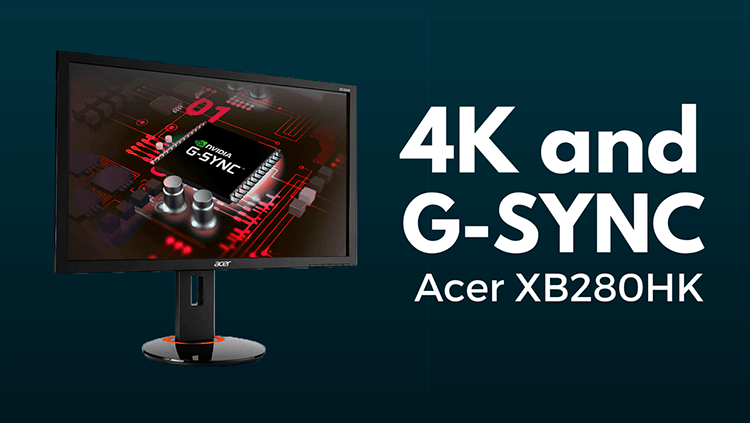The Acer XB280HK is the world’s first display with both 4K and G-SYNC technology. Acer monitors are highly respected in the gaming community, even among hardcore enthusiasts. There is also the ASUS ROG SWIFT PG278Q display, which was the first monitor with both G-SYNC and 1440p or WQHD resolution, but it offers even higher refresh rates up to 144Hz. But why is it important to have G-SYNC with 4K resolutions?
4K Resolution
Gamers, graphics designers, home theater lovers and techies alike are all abuzz about 4K, the hot new resolution that is coming to many devices like TVs and computer monitors. If you’re unfamiliar, see our earlier post – What is 4K? – Is It Good for Gaming?
Gaming at this high resolution presents a challenge. The new 4K resolution is so called because it has four times as many pixels as the familiar 1080p or Full HD resolution. The 1080p resolution is 1920×1080, and 4K is 3840×2160 – that is why it is sometimes called 2160p. Since there are four times as many pixels, your gaming PC has to work 4x harder.
Focusing on resolution alone, it is easy to forget about the frame rate. Since you have a set limit to the processing performance in your computer there is a trade-off between the detail in video frames (or high resolution) and drawing them quickly (frame rate). Some gamers prefer one over the other, but most will agree that a frame rate below 30 frame per second (FPS) is not acceptable – most would aim for 60+ FPS.
Not only does your computer have to be powerful enough to produce detailed video frames fast enough, your monitor also has to be able to display them. Oftentimes gamers will forget about the display, or at least give it a low priority when creating a budget for their new gaming PC. However the choice of monitor is really important as it will largely determine the limits of your gaming performance, and will usually remain constant as you upgrade your computer.
If you want to play video games in 4K now or in the future, choosing the right monitor is important. Connecting it properly is also important. To get the most out of your 4K monitor we recommend that you connect it via DisplayPort rather than HDMI. However current limitations with DisplayPort restrict your 4K display to a 60Hz refresh rate. DisplayPort 1.3 will allow 4K at 120Hz, but you’ll need a monitor that supports it as well as several graphics cards.
Similarly, the best monitors available right now are also limited to a 60Hz refresh rate at 4K. However producing 4K video frames 60 times per second is a strenuous task for any computer, including those with multiple high end video cards like the NVIDIA GTX 980Ti. Any computer would struggle to keep up with the display’s refresh rate. That could cause issues like stuttering and screen tearing.
These display errors occur when the frame rate produced by the graphics card falls out of sync with the refresh rate of the display. In simple terms, with a 60Hz refresh rate, this will happen anytime the frame rate goes above or below 60FPS. Stutter happens when the monitor shows the same frame for two or more refresh cycles – the video card can’t produce them fast enough. Screen tearing happens when the monitor shows two or more frames in a single refresh – imagine the top half of the screen has one frame image, while the bottom has another. This usually happens if the video card is sending frames faster than the display’s refresh rate. The frame rate will change drastically when you’re playing a game as some scenes are simply to render, while others are much more complicated.
NVIDIA G-SYNC
This is where NVIDIA’s G-SYNC technology comes in. A special chip in the monitor talks to the video card in the computer. This lets the monitor change its refresh rate to meet the frame rate of the graphics card – and vice versa. If the graphics card is producing frames too fast, G-SYNC will tell it to slow down so as to not create screen tearing. If the graphics card is producing them too slow, G-SYNC will tell the monitor to wait to refresh.
G-SYNC is probably most important in 4K gaming because of the strenuous demands for performance. If you were simply gaming at 1080p at 30 or even 60Hz, you could simply lock your graphics cards to 30 or 60FPS as long as they didn’t drop below that frame rate, and you wouldn’t need a monitor with G-SYNC. This is not the case with 4K when your graphics card(s) could drop below 60Hz.
